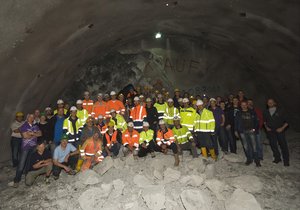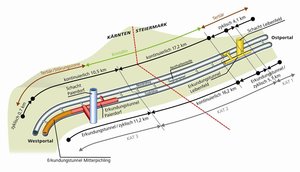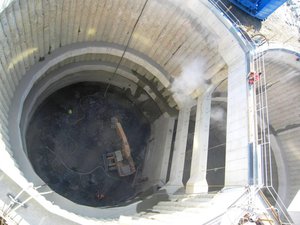
In 2011 ASFINAG, which is an Austrian operator of about 2,100 km of motorways including about 140 existing tunnels, was able to move forward on schedule with all its new and expansion projects. One particularly noteworthy event was the opening of the second tube of the 6.4 km long Tauern Tunnel (A10) for traffic on June 30, 2011, just in time for the summer holiday traffic. After 36 years of crossing the Alps through a single tube, the long traffic congestions in front of the tunnel are now a thing of the past. The high quality of the design and the construction work together with the use of new technologies helped, to overcome the extremely difficult geological situation, in an impressive manner. Whereas, for example, the settlements of the crown of the first tube reached values of up to 1.5m, the maximum deformation during the construction of the second tube was only about 0.5 m, thanks to the use of the latest knowledge regarding the NATM - New Austrian Tunnelling Method.

Good progress is also reported along the A9 constructing of the second tube of the Alpine-crossing 5.5 km long Bosruck Tunnel. The breakthrough was celebrated on August 10, 2011 (see figure 1). After opening the tunnel for traffic in 2013, the existing tube will be taken out of operation and given a total rehabilitation until 2015.
In 2012 ASFINAG is launching some other major tunnel projects like the construction of the double -tube, 4.5 km long Götschka Tunnel, which has already been started.
 The Austrian Federal Railway ÖBB reports on the Koralm railway which is - with a length of 127 km - part of the Trans European Network (TEN) and connects the Baltic States and Eastern Europe via Vienna with Northern Italy. The double tube Koralm Tunnel with a length of 32.9 km will be one of the longest railway tunnel in Europe. The tunnel alignment underpasses the mountain range of the Koralm with an overburden reaching approximately 1.200 m. With the excavation tertiary sediments near the portals and various series of metamorphic rocks will be encountered. The construction works for Koralm tunnel lot 1 (KAT1) have started in late 2008. Meanwhile excavation works, following the principles of NATM, have been completed and inner lining works are under progress. Lot 2 (KAT2) has started in January 2010. During the first year of construction site installation was performed, the sunk-down of the large dimension construction shaft was completed and approximately 2.5 km of tunnel excavation were carried out. By the middle of 2012 the installation of two hard-rock TBM-DS will take place. Additionally completion works for the ventilation shaft Paierdorf are running and tendering of the third lot KAT3 is planned by the end of 2012. All construction works and thus the start-up of the new railway line between Graz and Klagenfurt are intended to be completed in the year 2023.
The Austrian Federal Railway ÖBB reports on the Koralm railway which is - with a length of 127 km - part of the Trans European Network (TEN) and connects the Baltic States and Eastern Europe via Vienna with Northern Italy. The double tube Koralm Tunnel with a length of 32.9 km will be one of the longest railway tunnel in Europe. The tunnel alignment underpasses the mountain range of the Koralm with an overburden reaching approximately 1.200 m. With the excavation tertiary sediments near the portals and various series of metamorphic rocks will be encountered. The construction works for Koralm tunnel lot 1 (KAT1) have started in late 2008. Meanwhile excavation works, following the principles of NATM, have been completed and inner lining works are under progress. Lot 2 (KAT2) has started in January 2010. During the first year of construction site installation was performed, the sunk-down of the large dimension construction shaft was completed and approximately 2.5 km of tunnel excavation were carried out. By the middle of 2012 the installation of two hard-rock TBM-DS will take place. Additionally completion works for the ventilation shaft Paierdorf are running and tendering of the third lot KAT3 is planned by the end of 2012. All construction works and thus the start-up of the new railway line between Graz and Klagenfurt are intended to be completed in the year 2023.

The construction sector of ITA Austria informs that in the year 2011 PORR successfully completed the challenging projects Limberg II pumped-storage project, the second tube of the Tauern road tunnel and the Waidhofen city tunnel as well as the Wienerwald rail tunnel, Lot 33 of the Lainz rail tunnel and Lot H 3/4 of the Münster-Wiesing rail tunnel in the lower Inn valley, all located in Austria. The projects under construction – the Reisseck II pumped-storage scheme and exploration work for the Brenner Base Tunnel project – are proceeding speedily. The new contracts awarded to PORR include the large-scale Götschka twin-tunnel project of 4.4km length and the Freistadt by-pass with a tunnel length of 2.2km on the S 10 expressway between Linz in Austria and Ceske Budejovice in the Czech Republic. In addition contracts for a pipe-jacking lot for Fernwärme Wien district-heating system and the Ampass access tunnel for the Brenner Base Tunnel project were handed over to PORR as partners in joint ventures. Final work is under progress in Germany on the Finne Tunnel project on the Erfurt-Halle railway line - 2 tubes 6.6km long each - and the Osterberg Tunnel project - 2 tubes 2.2km long each. Successful breakthrough was celebrated on the Eierberge Tunnel of 3.7km length on August 29, 2011. Work on the final lining has already been started. The first EPB shield used on the Biel by-pass in Switzerland reached its successful breakthrough on the last of the four tubes under PORR's technical management on February 18, 2012. The largest job going to PORR leadership were the Filder- and the Ober-Untertürkheim tunnel lots under Porr management for the Stuttgart 21 mega project.

G. Hinteregger & Söhne Baugesellschaft m.b.H. with its headquarter in Salzburg and branch offices in Styria, Vienna and Carinthia has approximately 600 employees and is active in all sectors of the construction industry – in Austria and abroad. With the execution of over 200 kilometers of tunnels G. Hinteregger has become to a reliable partner in the construction of underground projects for private and public clients. The scope of works ranges from the execution of railway tunnels, road tunnels and subway tunnels, underground power plants, to small diameter service tunnels for water, sewage and cables using conventional driving methods (NATM) as well as tunnel boring machines in hard rock. Since Hinteregger has been involved in the construction of powerplants from its beginning, the company has a long experience using open TBMs in hard rock for headrace tunnels as well as for inclined shafts. Further more Hinteregger & Söhne offers services in old building rehabilitation, general contracting, foundation engineering and also environmental engineering.
JÄGER BAU GmbH was founded in Schruns, Austria in 1922 and their underground construction division has since been active in the realm of infrastructure projects, i.e. road and railway tunnels, irrigation and sewage and especially hydro power plants. JÄGER BAU continuously expanded activities beyond the traditional markets Austria, Germany and Switzerland to become an internationally acknowledged partner in the underground construction industry. Various demanding projects in Europe, Africa, South America and Asia - especially on the Indian sub-continent - have been completed to the fullest satisfaction of clients and partners in the recent past. JTS – JÄGER TUNNELLING SERVICES is a branch of the strategic business area `Underground Works´ within JÄGER BAU GmbH. The business concept - provision of comprehensive services for the underground construction industry - was developed in the 1980s and has been advanced continuously. JÄGER TUNNELLING SERVICES offer a wide spread portfolio of services throughout all project stages (pre-tender, pre-bid, pre-award, post-award stage and construction) either as a complete project service or through service modules, specifically tailored to suit the individual requirements of our clients, i.e. contractors, project owners and project developers - service as and when needed. Making use of a wide interdisciplinary and fast (re-)acting network of geotechnical consultants, design and engineering partners, JTS is able to provide comprehensive service packages. JTS’ core business is engineering as required for the construction phase of underground construction projects. Nevertheless Jäger Bau GmbH also assists and supports clients and partners during the planning, design and tender phase. Technical excellence, flexibility, experience, reliability, innovative approaches - are the main factors for the success in the tunnelling business.
IL - Laabmayr & Partner Consulting Engineers are working on major Austrian tunnel projects like overall design of refurbishment works for the 13.9km long Arlberg Road tunnel and together with ILF Innsbruck they are working on the tunnel Bosruck. Furthermore the Tunnels Klaus, Traunfried, Spering, Falkenstein, 4 motorway tunnels, 2nd tubes with a length of 2.9km, 2.2km, 0.8km, 0.5km are under overall design. Together with IGT the company of IL is working on the project of Tunnel Götschka, a double tube motorway tunnel, 2 x 4.43km. In Germany IL is working on the final design for the Tunnel Eierberge, l = 3.8km and the Tunnel Fleckberg, l = 1.4km, both situated on the new DB High Speed Railway Line Ebensfeld - Erfurt.
In 2011 GEOCONSULT was engaged in more than 100 projects worldwide. At the Koralm railway tunnel project Geoconsult performes design services during all project phases, beginning with feasibility studies and preliminary design to tender design and documents, detailed design and construction management. Also, services for the new tunnel projects on the HSR Stuttgart - Ulm in Germany have started. In South America, Geoconsult´s activities have continuously increased in major mining and infra-structure projects. On the mining sector, geotechnical design services for the Dacita Project of the Mine El Teniente, where the block caving method is applied for extraction of mainly copper and for the Mine Sierra Gorda of QuadraFNX Mining for the extraction of copper have started. On the infrastructure sector, relevant projects include the development of the basic design works for the bi-national corridor Agua Negra BaseTunnel, which will connect Argentina with Chile and the provision of design works for the Metro Buenos Aires and Santiago. In the field of large caverns the services performed for the Indian Strategic Petroleum Reserves Project (ISPRL) at the south Indian cities of Vishakhapatnam and Padur (approximately 1.3 million m3 of crude oil storage each), have to be mentioned, as in Padur the execution of the top headings is partly finished and benching has begun. Regarding the ongoing services for IRCON/Northern Railway for Tunnel 80 (Pir Panjal Railway Tunnel), an 11 km long railway tunnel in the Himalayas, the successful break-through of the top heading happened on 25th September 2011. In 2011 design and construction works started on the Perth City Link Rail Alliance project (sinking of the Freemantle railway line), for which Geoconsult is providing detail design of earth retaining structures, dewatering as well as construction impact assessment of the crossing with the existing railway tunnels. In the field of detail design of mass rapid transit subway projects, Geoconsult is involved in several contracts along the Downtown Line 2 (DTL2) in Singapore. Geoconsult is the lead designer for 2 deep MRT stations involving permanent diaphragm walls using top-down method for one station and conventional bottom-up with strutting for the other station. In addition Geoconsult is responsible for the detail design about 9 km of twin bored tunnels in mixed ground conditions (soft soil and granite), including cross passages, stretching over 6 construction contracts of the DTL2 line. In 2011 tunneling on all such TBM sections has commenced. In 2011 Geoconsult also became involved in the detail design of temporary works (retaining walls, work shafts, TBM launching structures, etc.) on 5 construction contracts along the total 21km long (16 stations) Downtown Line 3 (DTL3) in Singapore. With respect to underground road structures in Asia, Geoconsult is accredited checking engineers on three contracts of the Marine Coastal Expressway (MCE) in Singapore involving deep C&C excavations, including crossing of the Singapore river, in more than 50m thick layers of reclaimation sand and very soft marine clay material, requiring extensive ground treatment (up to 7m thick deep soil mixing and jetgrouting), as well as bored piles with lengths in excess of 80m. In 2011 the construction works on this project reached 80% degree of completion.
In 2011 Verbund, the biggest energy producer in Austria, took over operations of Limberg II in Salzburg Province. At the moment the Reißeck II project is under construction after having received regulatory approval in summer 2010. This project constitutes an investment of € 385 Mio, and connects two existing power plants types for an additional capacity of 430 MW. In summary, approximately 8 km of tunnels are to be conventionally constructed, 3.5 km are constructed using TBMs. The tunnel boring machine of Wirth for the 7.00 m wide pressure tunnel came into operation in 2011. The 45 degrees inclined shaft will also be conventionally constructed from the upper side and started in January 2012. The excavation of the Power station cavern with dimensions of 58x25x39 m was finished 2011.
SSP BauConsult in Innsbruck developed a new software for the calculation of advance rates in TBM tunnelling. By taking a new approach in modelling the tunnel boring process not as a continuous but as an intermittent process they have found a way to consider all influences on the boring process (geological, mechanical, operational etc.) in their prediction model. The software-tool SIMTUNNEL PRO includes the calculation of penetration and cutter wear, values that are required as basic input parameters for the calculation of the advance rate. The user can chose between the formulae of NTU, CSM, GEHRING, BÜCHI or an improved version of the GEHRING-Model. Apart from prediction of the advance rates the software can be utilised for comparison between calculated and actual performance. This is a valuable feature for the operational control of tunnel projects. Thanks to the facilities of data input it is possible to evaluate operational parameters like penetration, daily advance rate, downtime as well as mechanical parameters like thrust, cutter load, torque, upm on a daily basis. Before starting the work on the site the model should be updated by replacing the technical parameters of the TBM used in the calculation phase by those of the TBM actually employed on the site. Monitoring and evaluating the data from the initial bidding phase until the moment of break through provides valuable information on TBM performance and helps to identify the reasons for deviations.